new posts in all blogs
Viewing: Blog Posts Tagged with: app, Most Recent at Top [Help]
Results 1 - 25 of 38
How to use this Page
You are viewing the most recent posts tagged with the words: app in the JacketFlap blog reader. What is a tag? Think of a tag as a keyword or category label. Tags can both help you find posts on JacketFlap.com as well as provide an easy way for you to "remember" and classify posts for later recall. Try adding a tag yourself by clicking "Add a tag" below a post's header. Scroll down through the list of Recent Posts in the left column and click on a post title that sounds interesting. You can view all posts from a specific blog by clicking the Blog name in the right column, or you can click a 'More Posts from this Blog' link in any individual post.
The American Association of School Librarians (AASL), a division of the American Library Association (ALA), has revealed a list of the best apps for teaching and learning.
The list includes lists of apps in five different categories that are aimed at learning. The categories include: books; science, technology, engineering and math (STEM); organization & management; social sciences; and content creation. The apps include: David Wiesner’s Spot by Houghton Mifflin Harcourt; Loose Strands by Darned Socks Production; iBiome: Wetland by Spring Bay Studio; Remind by Remind 101 Inc.; and Amazing World Atlas by Lonely Planet, among others.
Here is more about the list from AASL’s site:
The apps recognized as Best Apps for Teaching & Learning are of exceptional value to inquiry-based teaching and learning as embodied in the AASL’s Standards for the 21st-Century Learner. The apps foster the qualities of innovation, creativity, active participation, and collaboration and are user friendly to encourage a community of learners to explore and discover.
Did you know that the History Channel has a "Planet H" that is creating apps? Just released yesterday (December 19, 2014) is Frontier Heroes. Don't buy it. It is supposed to be educational material developed in a game format. The description says:
Frontier Heroes tests your smarts, skills, and reflexes as you work your way through an illustrated version of American history, from pre-Colonial days through the California Gold Rush. Complete era-specific challenges to unlock more exciting adventures, and collect “Did You Knows” to learn mind-blowing facts about the ol’ US of A.
Experience what it was like to be alive during Early American times, the Colonial Period, the American Revolution, life on the Frontier and during The Gold Rush. You’ll get a rush from completing each level and seeing how the challenges and rewards led to the amazing country America is today.
There's a video that shows you the game. Here's the welcome page:
The first stop on this path? "Early America." See the Indian girl? She might be waving at you, but based on what the rest of the Early America game and graphics look like, my guess is that the developers think they are showing her in that classic (not) way that Indians say hello: "How!" Oh yeah... Indian flute music plays in the background for the page. Here's the graphic:
In the first game (with the skull) you're supposed to throw a tomahawk at a target, and then a buffalo skull, and then a large bowl, and then a pumpkin. There's tipis in the background. The first target is the only one that kind-of makes sense. The others? Nope. Realistically speaking, why would you want to destroy those items?!
In the second one (top row, middle), you stand on a hollow log and shoot a bow and arrow across a chasm. Why? Maybe because few things say "Indian" as much as a bow and arrow.
In the third one, you "play" a "war drum" by striking your mallet on the drum according to the sequence of dots that scroll across the screen. That music is goofy, too, by the way and sounds nothing like any Native drum I've ever heard. A flute pops in here and there, as does some war whooping.
As you play these games, you might get lucky and earn a D.Y.K. (which stands for DID YOU KNOW). In the drum one, the D.Y.K. says "Native Americans believe the drum carries the heartbeat of Mother Earth." For some Native Nations, maybe, but all? I don't think so.
In the fourth one, you use the string of your bow to rotate a stick as fast as you can so that you can start a fire before the timer runs out. If you don't get the logs blazing, you'll see this picture, 'cept you (as that Indian girl) will be shivering:
Logically speaking, WHERE IS HER OUTER CLOTHING? Maybe there's a storyline about how she got captured by an enemy tribe or some white trappers, but that she got away and is trying to get back to her people. That's snark, by the way... And---the D.Y.K. for this game? "Native Americans used smoke signals to communicate over long distances." Who ARE the people writing this stuff? They ought to be fired. They are hitting all the stereotypes!
If you don't get the fire started before time is up, you'll see this:
Missing an apostrophe there, H-Planet!
There's one more game in this "Early America" part of the game. Your task is to get kernels off a cob of corn and grind them up to make cornmeal.
Let's pause for a word about that phrase, "Early America." It isn't accurate to call pre-colonial times "Early America." Each Native Nation had its own name for its homelands. America was not one of the names any of them used.
As noted in the description above, there are several other time periods in this game but I'm not going to look at them. What I've seen is enough for me to say...
Do not waste your money
on H-Planet's Frontier Heroes.

Title: Sphere 360º
Platform: iOS, with some limitations
Cost: Free
Sphere 360º bills itself as "the future of photography." It adds a three dimensional aspects to your panoramic shots, with sometimes startling results. Be it a Siberian forest or an Italian coastline, there's a definite concrete virtual reality aspect to viewing a "sphere."
The gallery of shared spheres is pretty intimidating. Many are taken with a rotating gadget called a Motrr, which can be controlled wirelessly. There is an "easy" mode, but there is a definite art to creating a sphere. Additionally, you must be connected to a network, which could make capturing nature scenes difficult
To begin your sphere, you can scan a panorama or upload one saved to your camera roll. To complete the sphere, you use your finger to create details and depth, essentially zooming in and moving around to flesh out the experience of being there.
If that's not enough to get your teens interested, Kendall Jenner recently recommended it her recent Vogue interview with an enthusiastic "Download immediately."
Even is you never create a sphere, the curated collections with their intuitive and smooth navigation could be a boon for teachers and librarians looking to take student beyond the herky-jerky vagueness of Google Earth. And it's too kinesthetic to it justice outside the app.
The current version doesn't seem to be supported on the latest Apple hardware, so it's the rare case where something interesting isn't available on the newest devices.
Creator Spherical also has a 4D video app called Play, which is also free for a limited time.
If you have a suggestion for an App of the Week, let us know, and be sure to check out more great Apps of the Week in our archive.

By:
Gi Hallmark,
on 10/20/2014
Blog:
The Children's Book Review
(
Login to Add to MyJacketFlap)
JacketFlap tags:
Music,
Ages 0-3,
Ages 4-8,
Interactive,
Bilingual Books,
Mice,
Author Showcase,
Friendships,
App,
Animal Books,
Harvey Stevenson,
iBook,
eBooks & Apps,
App Books,
Gyophare Editions,
Multi-Lingual Options,
Add a tag
Topo's Piano encourages and inspires young budding musicians to create their own melodies and discover the many joys and gifts of music.

By: Elizabeth Gorney,
on 8/9/2014
Blog:
OUPblog
(
Login to Add to MyJacketFlap)
JacketFlap tags:
Books,
Technology,
facebook,
digital,
privacy,
Media,
social media,
online,
clients,
donuts,
psychotherapy,
apps,
client,
APA,
app,
Psychotherapist,
*Featured,
American Psychological Association,
Psychology & Neuroscience,
APA2014,
Jan Willer,
The Beginning Psychotherapist's Companion,
therapist patient relationship,
psychotherapists,
psychotherapist’s,
willer,
Add a tag
By Jan Willer
Social media and other technologies have changed how we communicate. Consider how we coordinate events and contact our friends and family members today, versus how we did it 20 or 30 years ago. Today, we often text, email, or communicate through social media more frequently than we phone or get together in person.
Now contrast that with psychotherapy, which is still about two people getting together in a room and talking. Certainly, technology has changed psychotherapy. There are now apps for mental health issues. There are virtual reality treatments. Psychotherapy can now be provided through videoconferencing (a.k.a. telehealth). But still, it’s usually simply two people talking in a room.
Our psychotherapy clients communicate with everyone else they know through multiple technological platforms. Should we let them “friend” us on social media? Should we link to them on professional networking sites? Is it ok to text with them? What about email? When are these ok and not ok?
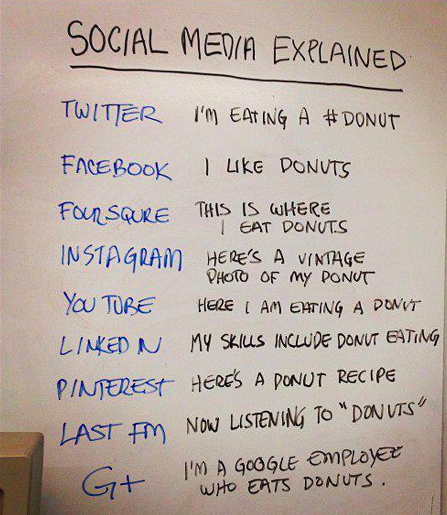
Social Media Explained (with Donuts). Uploaded by Chris Lott. CC-BY-2.0 via Flickr.
Some consensus is emerging about these issues. Experts agree that psychotherapists should not connect with current or former clients on social media. This is to help preserve the clients’ confidentiality. Emailing and texting are fine for communicating brief messages about the parameters of the session, such as confirming the appointment time, or informing the psychotherapist that the client is running late. Research has shown that emotional tone is frequently miscommunicated in texting and email, so emotion-laden topics are best discussed during the session.
How do we learn about new people we’ve met? In the past, we’d talk directly to them, and maybe also talk to people we knew in common. Now everyone seems to search online for everyone else. This happens frequently with first dates, college applicants, and job applicants.
Again, contrast this with psychotherapy. Again, two people are sitting in a room, talking and learning about each other. When is it ok for a psychotherapist to search for information about a client online? What if the psychotherapist discovers important information that the client withheld? How do these discoveries impact the psychotherapy?
No clear consensus has emerged on these issues. Some experts assert that psychotherapists should almost never search online for clients. Other experts respond that it is unreasonable to expect that psychotherapists should not access publicly available information. Others suggest examining each situation on a case-by-case basis. One thing is clear: psychotherapists should communicate with their clients about their policies on internet searches. This should be done in the beginning of psychotherapy, as part of the informed consent process.
When we’ve voluntarily posted information online–and when information about us is readily available in news stories, court documents, or other public sources–we don’t expect this information to be private. For this reason, I find the assertion that psychotherapists can access publically available information to be more compelling. On my intake forms, I invite clients to send me a link to their LinkedIn profile instead of describing their work history, if they prefer. If a client mentions posting her artwork online, I’ll suggest that she send me a link to it or ask her how to find it. I find that clients are pleased that I take an interest.
What about the psychotherapist’s privacy? What if the client follows the psychotherapist’s Twitter account or blog? What if the client searches online for the psychotherapist? What if the client discovers personal information about the psychotherapist by searching? Here’s the short answer: psychotherapists need to avoid posting anything online that we don’t want everyone, including our clients, to see.
Ways to communicate online continue to proliferate. For example, an app that sends only the word “Yo” was recently capitalized to the tune of $2.5 million and was downloaded over 2 million times. Our professional ethics codes are revised infrequently (think years), while new apps and social media are emerging monthly, even daily. Expert consensus on how to manage these new communications technologies emerges slowly (again, think years). But psychotherapists have to respond to new communications technologies in the moment, every day. All we can do is keep the client’s well-being and confidentiality as our highest aspiration.
Jan Willer is a clinical psychologist in private practice. For many years, she trained psychology interns at the VA. She is the author of The Beginning Psychotherapist’s Companion, which offers practical suggestions and multicultural clinical examples to illustrate the foundations of ethical psychotherapy practice. She is interested in continuing to bridge the notorious research-practice gap in clinical psychology. Her seminars have been featured at Northwestern University, the University of Chicago, and DePaul University.

Subscribe to the OUPblog via email or RSS.
Subscribe to only psychology articles on the OUPblog via email or RSS.
The post My client’s online presence appeared first on OUPblog.


By:
Roberta Baird,
on 5/7/2014
Blog:
A Mouse in the House
(
Login to Add to MyJacketFlap)
JacketFlap tags:
animals,
children's illustration,
Texas,
dawn publications,
digital art,
roberta baird,
Promotion,
alligator,
artwork,
houston,
a mouse in the house,
marianne berkes,
children's book art,
app,
www.robertabaird.com,
#childrensbooks,
#kidlitart,
The Swamp Where Gator Hides,
Books,
illustration,
Add a tag
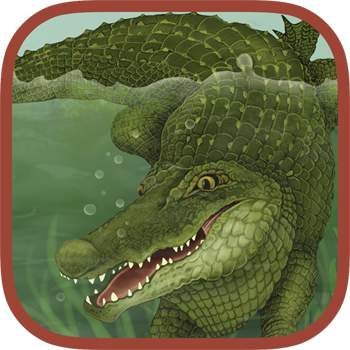
The Swamp Where Gator Hides written by Marianne Berkes and illustrated by me, Roberta Baird is now an app!! Click here to download it at 20% off! Dawn Publications Book App
Preview it now!

Friends and I got to talking and I mentioned I plan to develop apps based on a few of my books. One friend, Sara, said, “Bill Finger?”
We then collaborated on the idea for such an app: open the app and walk by any comic containing any Batman story and it will tell you if that Batman story was written by Bill Finger.
.png.jpg?picon=3008)
By: Maria Gill,
on 3/6/2014
Blog:
KidsBooksNZ
(
Login to Add to MyJacketFlap)
JacketFlap tags:
app,
Add a tag
Sneezle Beezle: He runs on diesel by Bruce Laybourn, illustrated by Vincent de Jong
 Sneezle Beezle is a small mechanical boy crafted in the workshop of a monastery high in the Himalayas. He earned his name through the funny little noises that he makes.
Sneezle Beezle is a small mechanical boy crafted in the workshop of a monastery high in the Himalayas. He earned his name through the funny little noises that he makes.
At the age of three months (which is six years in human terms)
Sneezle Beezle sets out to discover his place in the world.
This is the story of his adventure.
We are introduced to the maker before Sneezle Beezle makes his journey across seas into the bedroom of six-year-old Dylan. Dylan must work out how Sneezle Beezle runs - a little sneezle gives the answer.
Written in rhyme with assonance (junk, bunk, trunk) placed in the middle and end of each line, makes it fun to read aloud to young children. The illustrations of Dylan are modelled on the real-life son
of the author - which is a real interesting story on its own (written on last page). Dylan was kidnapped by his mother and taken to Turkey. Author Bruce Laybourn wrote the stories as a means to help he and his son communicate from opposite sides of the world.
The artwork by Vincent de Jong is sometimes quite moody capturing the severe weather in the Himalayas, and later on in the book, quite light - when showing Sneezle communicating with his new-found friend. The illustrations look like they have been drawn on the computer, and sometimes include photograph backdrops.
Note: The layout of the app is in printed book format so you need to flick past several pages before getting to the start of the story.
See the website
Available to buy on iTunes for $7.99
WP Photos is a nifty new photoblogging app for Firefox OS that works with your WordPress.com or self-hosted WordPress blog.

Photo sharing made simple
WP Photos is a straightforward, no-nonsense photoblogging app that streamlines your photo sharing experience. Take a picture. Add a title, caption, tags, and a short message. Then, upload it to your blog. It’s as simple as that!

What is Firefox OS?
Created by Mozilla, the makers of the Firefox web browser, Firefox OS is an operating system that debuted earlier this year and powers smartphones in thirteen countries across Europe, Latin America, and South America — and more to come. Firefox OS is similar to Apple’s iOS and Google’s Android operating systems, but one notable thing setting it apart is its reliance on Open Web Standards instead of proprietary technologies.
Download the app now
WP Photos is currently featured in the Firefox Marketplace. If you have a Firefox OS phone, we encourage you to download the app for free. We’d love for you to try it out, add photos to your blog, and tell us what you think. If you need assistance, please contact Support or send a note to [email protected].
Filed under:
Applications,
Mobile,
Photos,
Posting 

Apple just released the new version of their mobile operating system, iOS 7, with a new user interface that streamlines both form and function — it’s colorful and intuitive, but stripped-down and clean. Apple fans have been abuzz since they announced the update a few months ago, and we started …

By:
Tonia Allen Gould,
on 9/12/2013
Blog:
Tonia Allen Gould's Blog
(
Login to Add to MyJacketFlap)
JacketFlap tags:
ebooks,
EReader,
app,
beach books,
Today's Parent,
Author Posts,
eBook Apps,
#kidlit,
#SamuelTMoore,
children's book market,
Tonia Allen Gould,
Picture Book,
parenting,
Add a tag

Jacob, age 6, with his Samuel T. Moore of Corte Magore App on the iPad
Bi-line article written for Today’s Parent USA by Tonia Allen Gould
This fast-paced media environment we are experiencing today is continuously changing and has everyone confused. Parents too, are having a hard time catching-up on evolving trends. Like everyone else, they are trying to figure it all out, while their children seem to adapt and grasp onto technology without even a glimmer of thought. Look around you—in airport terminals, at outdoor cafes, and at the nearest Starbucks, it’s not uncommon to see a child, sometimes as young as two years old, sitting quietly and comfortably, glaring through the glossy screen of an iPad. One thing is for certain; these children are engaged and consumed by the technology they are accessing from the palm of their hands.
Today, there are an abundance of apps that can be accessed through general purpose tablets like the iPad. With only a touch of a finger, and a few moments of time, you can browse through books, games and educational apps for children from the iTunes App Store, for example, on your device. With so many options in front of you, it’s important to understand the landscape of where book media is today and where it is going, especially in the education and entertainment arenas. Picture books, for instance, on technology devices have turned into interactive, engaging “experiences,” complete with digital animation, narration and music. While we all hope that conventional books in the library will never really be replaced, it’s true that in just a few short years, book apps and eBooks have already changed the publishing world and redefined how books come to market. In fact, some book apps are starting to look something more like a Disney/Pixar movie than an actual picture book, and the book market will only get better from here.
Also, it’s important to understand that there are significant costs that go into the production of a single book app and this is why the good ones can’t be purchased for the price of a song. Still at $1.99-$7.99 or higher, the cost of a book app may be a much better value when compared to printed and bound books stocked at brick and mortar retailers like Barnes and Noble, where you can expect to pay at least twice the price of a book app or eBook. It’s these very same electronic books that can be found at other retailers, like Amazon, that are partially responsible for those big retailer’s declining sales.
It’s true that just a few short years ago; kids were snuggling up next to their parents to have a book read to them when their parents could take the time to sit down with them. Today’s kids are getting their books on demand and being read to by professional narrators, when mom’s lap isn’t available, and they are doing this right from the comfort of their own electronic devices. For parents, the reality is you don’t need to draw a line in the sand, and purchase your child’s books one way or the other. What’s most important is that your child is reading. Books of any kind are a good way for kids to start thinking and speaking early, but I for one, am looking forward to the positive influence technology can bring to those young minds.
Tonia Allen Gould is the producer and author of Samuel T. Moore of Corte Magore, an electronically published book app, available in the App Store on iTunes, and is also available by audio on CD Baby and through other media outlets. Published by Skies America, Gould creatively directed and hand-picked the celebrity talent to make this eBook/app an engaging experience for children ages four to eight-years-old. The app was illustrated by Marc Ceccarelli, a SpongeBob SquarePants storyboard director. It was narrated by two-time Marconi Award nominee, and radio personality, Mr. Steve McCoy. The original musical score was produced by country artist, Robby Armstrong.


Barnes & Nobles hat unser E-Book mit der höchsten Bewertung versehen !
Sie können es direkt über Barnes & Nobles, Apple, bei Amazon oder über die Links auf meiner E-Book Seite bestellen.
Here’s an interesting infographic from Kite Ebook Readers, which specializes in making children’s ebooks and apps.
This infographic is from kitereaders.com.


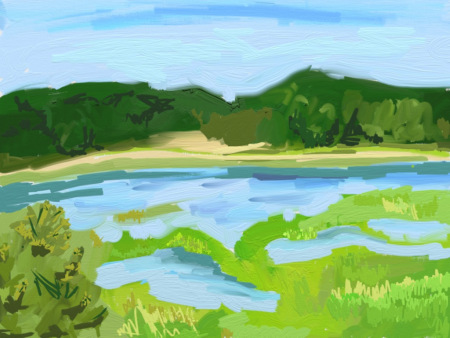
Here’s my view of Truro, Massachusetts, where we visited old friends. I used the ArtRage app with my Sensu Brush on my iPad. I seem to “paint” mostly when I’m on vacation. Love Cape Cod!
More digital artwork to come. For some of my previous iPad paintings, click here and here.



By:
Tonia Allen Gould,
on 5/26/2013
Blog:
Tonia Allen Gould's Blog
(
Login to Add to MyJacketFlap)
JacketFlap tags:
author,
Children,
Uncategorized,
Picture Book,
Ebook,
Download,
iTunes,
Narrated,
EReader,
Animated,
app,
Gould,
My Journey to Become an Author,
Tonia Allen Gould,
Add a tag
Samuel T. Moore of Corte Magore, an animated and narrated children’s picture book releases on 7/1/13!



By:
Tonia Allen Gould,
on 5/1/2013
Blog:
Tonia Allen Gould's Blog
(
Login to Add to MyJacketFlap)
JacketFlap tags:
Narrated,
EReader,
tale,
childrens,
Animated,
app,
beach books,
My Journey to Become an Author,
Corte Magore,
fiddler crab,
Uncategorized,
Picture Book,
Poetry,
book,
Ebook,
Passion,
Download,
iTunes,
Tonia Allen Gould,
Add a tag

Author, Tonia Allen Gould, announces the release date of her animated and narrated children’s picture book, coming on 7/1/13 on iTunes.


.jpeg?picon=3281)
By: Dain Fagerholm,
on 3/28/2013
Blog:
Art & Drawings by Dain Fagerholm
(
Login to Add to MyJacketFlap)
JacketFlap tags:
dain fagerholm,
penrose,
asylum maze game,
puzzle,
3d,
blue girl,
app,
kickstarter,
ios,
Add a tag
 If you use the Amazon Kindle app on your Apple device, you should not install the latest update for the app. According to some sources, the update could hurt your entire library.
If you use the Amazon Kindle app on your Apple device, you should not install the latest update for the app. According to some sources, the update could hurt your entire library.
AppNewser has more details:
Do you like reading eBooks on your iPhone or iPad using Amazon’s Kindle app? Then here’s a tip, don’t download the latest update 3.6.1. This advice is coming straight from Amazon. The company posted this note on the app’s listing in iTunes: “There is a known issue with this update. If you are an existing Kindle for iOS user, we recommend you do not install this update at this time.”
New Career Opportunities Daily: The best jobs in media.
![photo[4]](http://blog.boomerangbooks.com.au/wp-content/uploads/photo41.jpg) There are some weeks so bad that only comfort food and obscenely expensive aspirational purchases can save you. I’d argue I’ve just had one of those, having found out I have two tears in my knee and require an arthroscopy, getting flooded twice as badly as I did in 2011, and discovering that my stove has sprung a mammoth gas leak that will need wall-punchingly expensive plumbing repairs.
There are some weeks so bad that only comfort food and obscenely expensive aspirational purchases can save you. I’d argue I’ve just had one of those, having found out I have two tears in my knee and require an arthroscopy, getting flooded twice as badly as I did in 2011, and discovering that my stove has sprung a mammoth gas leak that will need wall-punchingly expensive plumbing repairs.
So, although I’d like to say that I bought my long-awaited, much-adored iPad Mini under happy circumstances (perhaps even—as I inadvertently worded it the other day—getting the clap on the way out of the Apple store), it’s come more as a consolation prize.
As consolation prizes go, though, I’m not complaining. The iPad Mini’s pretty incredible, and in just a few short days and limited plays, I’ve fallen in love with the following …
Its ereader capabilities
 I’ve held out buying an ereader until now because I’m a dedicated worshipper of the cult of Apple, because I wanted to wait until the format wars died down, and because no ereader on the market did quite what I’d hoped (read: none were ‘Apple pretty’).
I’ve held out buying an ereader until now because I’m a dedicated worshipper of the cult of Apple, because I wanted to wait until the format wars died down, and because no ereader on the market did quite what I’d hoped (read: none were ‘Apple pretty’).
The crisp, white, Garamond font-inked pages unfurling on the iPad Mini actually made my heart soar. The handy functionality that enables me to highlight paragraphs, add notes, and more kind of make me wonder if I’ll ever return to physical copies, where I’m forced to dog-ear pages, add post-it notes that easily become unstuck, and rustle through pages down the track when I’m looking for a quote about something interesting that I vaguely remember marking somewhere along the way. In short, I’m obsessed with it and am currently plotting which ebooks I should buy.
Its accompanying magnetic cover
 I had to buy it separately, but the iPad Mini’s light grey, magnetised cover that snaps on and snaps to without affecting usability or streamlined pretty is fantastic. Sometimes it’s the little things that really please.
I had to buy it separately, but the iPad Mini’s light grey, magnetised cover that snaps on and snaps to without affecting usability or streamlined pretty is fantastic. Sometimes it’s the little things that really please.
The Sydney Morning Herald (SMH) app
 There are, rather confusingly, two SMH apps, and I downloaded both before discovering that the one I want appears in the iPad Mini’s newsstand. And, despite the initial confusion, the correct app’s proving brilliant. Indeed, traditional newspapers may be struggling to make the digital shift, but you wouldn’t know if from Fairfax’s SMH app. It’s crisp, clear, image-driven, and extremely aesthetically appealing. It’s also packed with handy functions to save stories for later, share with others, and jump to favourite sections.
There are, rather confusingly, two SMH apps, and I downloaded both before discovering that the one I want appears in the iPad Mini’s newsstand. And, despite the initial confusion, the correct app’s proving brilliant. Indeed, traditional newspapers may be struggling to make the digital shift, but you wouldn’t know if from Fairfax’s SMH app. It’s crisp, clear, image-driven, and extremely aesthetically appealing. It’s also packed with handy functions to save stories for later, share with others, and jump to favourite sections.
I’m pretty sure this newspaper app will be my gateway app to the likes of apps for the New Yorker, Longform, and the New York Times.
The Foxtel Go app
![photo[3]](http://blog.boomerangbooks.com.au/wp-content/uploads/photo33.jpg) Released just a few weeks ago and sounding far too good to be true, this app enables you to connect two iPads/iPad Minis to one Foxtel subscription. My parents have two Foxtel connections these days purely because they were sick of me poaching the TV to watch football at precisely the same time they wanted to watch some form of British TV.
Released just a few weeks ago and sounding far too good to be true, this app enables you to connect two iPads/iPad Minis to one Foxtel subscription. My parents have two Foxtel connections these days purely because they were sick of me poaching the TV to watch football at precisely the same time they wanted to watch some form of British TV.
I’ve long since moved out and drive back over to take advantage of said second Foxtel connection (I mean, it’s not as if I can afford to install Foxtel at my own place) and, though I’d heard I could effectively siphon off their connection to my iPad Mini, I was convinced it wouldn’t work. Surely Foxtel would detect I wasn’t on the same network, that I in fact wasn’t even in the same house?
It turns out not (although I’m still unsure whether this is deliberate or an as-yet-undiagnosed quirk), and I can now successfully pilfer Foxtel’s football from my parents’ connection. Provided it doesn’t change the ‘loophole’, Foxtel Go is officially the best. app. ever.
Finding out what’s next
I’m just days into my iPad Mini discovery tour, so I’m sure there are more than a billion features and apps I’ve not yet discovered. Are there any you’d recommend I download immediately and roadtest?
*Please excuse my rather dodgy phone photos—I’m a little incapacitated and a lot a fan of take-it-from-your-phone efficiency and ease. You get the right idea from them, yeah?
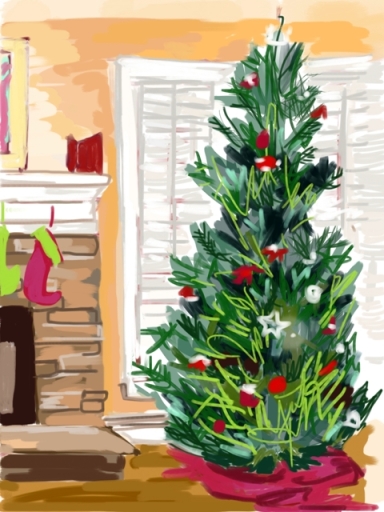
In my previous post, “Painting by App Part I,” I talked about using Brushes and Sketchbook Pro and showed samples of my work made with these apps.
The next two apps I tried were Procreate and Artrage, this time with a stylus called a Sensu Brush. The Sensu brush was a gift (thanks, in-laws!) and I have to say, drawing on the iPad is a way better experience with it. Finger painting on a device is totally fun and may suit your needs, but if you want more control, definitely get a quality stylus.
The stylus itself isn’t magical, but it’s much more like drawing with a pen, and, in the case of the Sensu, with a brush. The Sensu has a rubberish tip on one side and a brush on the other. As far as I can tell the bristles themselves don’t really seem different from those on a regular watercolor brush, but I haven’t done an iPad comparison. Have you?
The Christmas tree image above was made using Procreate. What I love about Procreate is the ability to change not only colors, tools, and stroke width but also the paint load and tons of variations of brush stroke. Changing the “load” and brush type means you can control how much color you want on your brush and the shape your brush makes, plus the amount of water that’s mixed with your paint. These items are key to making your digital image look painterly.
The following three images were made using Artrage, which is my favorite art app so far. Here’s why:
1) Artrage not only lets you paint with virtual oils or acrylics, it lets you squirt them out on the screen and mix them with your brush (or other tools). This feature alone makes the pricetag ($6.99) worth it.
2) You can upload a reference photo and pin it in the corner of your screen while you’re painting. So cool.
3) You can zoom in and out of your painting so you can work on detail areas or see the big picture quickly.
4) You can choose from among many paper and canvas options in any color you like.
5) Another favorite feature! You can change the drying time to your paint. This doesn’t sound like much, but it allows you to either mix colors on the canvas or, in the case of oils, pretend several days have passed and it’s “dry” enough to paint on top of your underpainting. Sweet.
6) You can add “water” or “solvent” (depending on your paint type) to thin it down. Like the drying time, this feature allows you to control how your current paint color will interact with the colors you’ve already painted.
7) There’s a wide variety of choices of how your brush carries the paint. I’m personally a fan of the dry brush options.
One wish for Artrage, and it’s a small one, is that you could use the edge of the palette knife for scraping off color (currently I can only figure how to use the flat of the knife for mixing).
The images below were done at Cedar Cliff Lake in North Carolina. The first is an earlier version of the second image. The last is somewhat unfinished but I figured I’d go ahead and share.
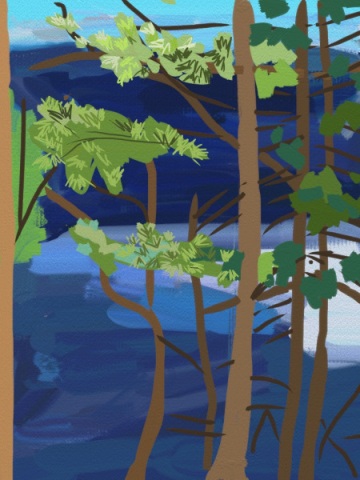
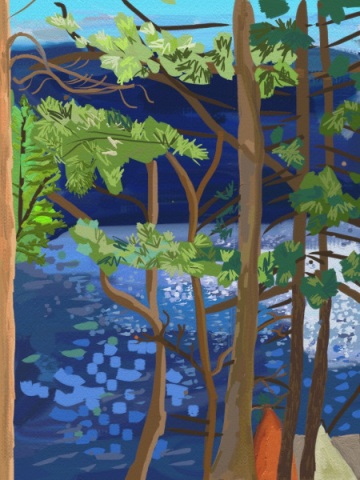
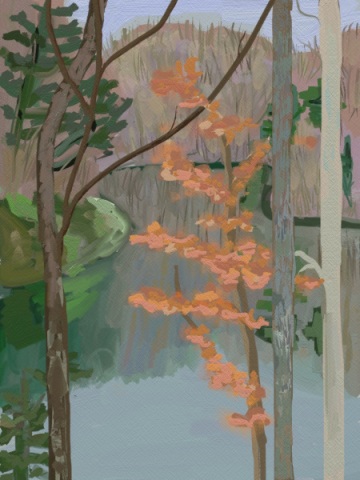
All of the apps I tried have their strong points, and in the end, you have to decide what you really want out of an art app. Is it a quick sketching tool for you, or are you interested in creating more intricate pieces? Do you want to approximate watercolors, pen and ink, or oils? You can make beautiful images with all of them, but for more painterly effects, I would go for Procreate or Artrage, and Artrage is definitely the choice for anyone wanting an acrylic or oil paint look.
I’d also like to try Auryn Ink, a watercolor app, but recent reviews of it (regarding compatbility with the new iPad) were pretty poor, so I’m hoping they’ll update soon.
Thanks for hanging with me through this lengthy and fairly technical post. Back to regularish programming soon!
p.s. On an unrelated note, I just heard an interview with Lindi Ortega and was totally mesmerized by her music. Try this tune here. She’s kind of a modern Johnny Cash/ Dolly Parton mashup though maybe more on the rockabilly side than strict country. She’s playing at the Evening Muse tonight in Charlotte. Wish I could go! Let me know if you do.



In my previous post, “Painting by App Part I,” I talked about using Brushes and Sketchbook Pro and showed samples of my work made with these apps.
The next two apps I tried were Procreate and Artrage, this time with a stylus called a Sensu Brush. The Sensu brush was a gift (thanks, in-laws!) and I have to say, drawing on the iPad is a way better experience with it. Finger painting on a device is totally fun and may suit your needs, but if you want more control, definitely get a quality stylus.
The stylus itself isn’t magical, but it’s much more like drawing with a pen, and, in the case of the Sensu, with a brush. The Sensu has a rubberish tip on one side and a brush on the other. As far as I can tell the bristles themselves don’t really seem different from those on a regular watercolor brush, but I haven’t done an iPad comparison. Have you?
The Christmas tree image above was made using Procreate. What I love about Procreate is the ability to change not only colors, tools, and stroke width but also the paint load and tons of variations of brush stroke. Changing the “load” and brush type means you can control how much color you want on your brush and the shape your brush makes, plus the amount of water that’s mixed with your paint. These items are key to making your digital image look painterly.
The following three images were made using Artrage, which is my favorite art app so far. Here’s why:
1) Artrage not only lets you paint with virtual oils or acrylics, it lets you squirt them out on the screen and mix them with your brush (or other tools). This feature alone makes the pricetag ($6.99) worth it.
2) You can upload a reference photo and pin it in the corner of your screen while you’re painting. So cool.
3) You can zoom in and out of your painting so you can work on detail areas or see the big picture quickly.
4) You can choose from among many paper and canvas options in any color you like.
5) Another favorite feature! You can change the drying time to your paint. This doesn’t sound like much, but it allows you to either mix colors on the canvas or, in the case of oils, pretend several days have passed and it’s “dry” enough to paint on top of your underpainting. Sweet.
6) You can add “water” or “solvent” (depending on your paint type) to thin it down. Like the drying time, this feature allows you to control how your current paint color will interact with the colors you’ve already painted.
7) There’s a wide variety of choices of how your brush carries the paint. I’m personally a fan of the dry brush options.
One wish for Artrage, and it’s a small one, is that you could use the edge of the palette knife for scraping off color (currently I can only figure how to use the flat of the knife for mixing).
The images below were done at Cedar Cliff Lake in North Carolina. The first is an earlier version of the second image. The last is somewhat unfinished but I figured I’d go ahead and share.



All of the apps I tried have their strong points, and in the end, you have to decide what you really want out of an art app. Is it a quick sketching tool for you, or are you interested in creating more intricate pieces? Do you want to approximate watercolors, pen and ink, or oils? You can make beautiful images with all of them, but for more painterly effects, I would go for Procreate or Artrage, and Artrage is definitely the choice for anyone wanting an acrylic or oil paint look.
I’d also like to try Auryn Ink, a watercolor app, but recent reviews of it (regarding compatbility with the new iPad) were pretty poor, so I’m hoping they’ll update soon.
Thanks for hanging with me through this lengthy and fairly technical post. Back to regularish programming soon!
p.s. On an unrelated note, I just heard an interview with Lindi Ortega and was totally mesmerized by her music. Try this tune here. She’s kind of a modern Johnny Cash/ Dolly Parton mashup though maybe more on the rockabilly side than strict country. She’s playing at the Evening Muse tonight in Charlotte. Wish I could go! Let me know if you do.


One of the things I LOVE about Sylvan Dell, is how they embrace technology.
They now have an app available with the books I illustrated for them! So cool!
We are very excited to announce the launch of our “Fun eReader” iPad App.
Enjoy with this 30-day free trial offer!
Picture carrying 76 ebooks to inspire reading and teach children about science and math. Now all the great things you have loved about Sylvan Dell books are available in one spot on the iPad or any flash capable device. Covering tough science and math subjects through picture books children will digest amazing facts about strange animals, faraway places, earth systems, and even math concepts. |
|
|
| Free Trial: Login only as a School Site License User by entering 2WZ637 into the Red box at the bottom of the iPad App Registration page. Trial Expires Nov 15th. |
|
|
|
Features include: · 76 eBooks each with Read-to-Me / Read-toMyself, Auto Play, and English / Spanish selection on the fly. · Cloud and Download eBook play. High speed internet needed for cloud viewing · Download, Uninstall, Buy Now options via MyAccount page. · Drag, Tap, and Flick page turning · Easy Registration for: (1) New Users, (2) existing Personal eLibrary customers, and (3) School and Library eBook Site License users. · Viewable on iPads, computers, and flash compatible devices. |
Share! If you love Fun eReader shout about it in iTunes and rate us in customer reviews. If you have any questions please email or call us at (877) 243-3457
|
Tales for Great Grandchildren
Interactive stories for the iPad or Kindle.
‘...Beautifully crafted stories with magical illustrations that come to life...’
Tales for Great Grandchildren, first published in hardback in 2011 limited edition, has evolved, embracing the ‘new’ revolution that is muscling its way, quite nicely, into the world of publishing!
So, when I as first asked to review this app, I was intrigued. Could a book really hold a candle to a traditional book? Could it add another dimension to my reading experience? Well, I thought, I was about to find out...
Tales for Great Grandchildren is a collection of classical stories inspired by the folklore and mythology of ancient India and Nepal. With stories of flying turtles, a magic goat and a very clever rabbit called Vijaya, to name a few, you’re certainly not short of something different.
 |
| John Jackson |
I read this iPad app with my 6 year old, and I have to say, it was a throughly enjoyable experience! Given the choice, we could either read it together, or, with the touch of a button, have it read to us by the author himself, John Jackson. Impressive.
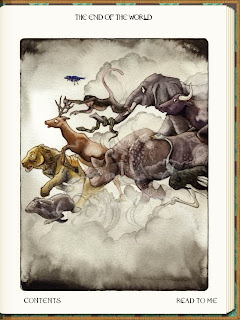 |
| The End of the World |
Now, this is where I truly believe the magic happens; a place (do I dare say it) where a paper book can never compete: the illustrations come to life! It’s like standing in the middle of a Harry Potter film. There are even sound effects! Talk about taking the reading experience to another level. Perfect.
I loved them, my son adored them even more and that’s no mean feat, I can assure you!
...And it doesn’t end there. There is a chapter ‘
Tales Behind the Tales’, crammed full of extras (and we all like extras), including two short ‘making of’ films: ‘
Inspiration Behind the Tales’ and ‘
The Illustrative Journey
Kindle App Upgraded
Amazon has released a major update to its Kindle app for Android, and it basically turns any Android phone or tablet into a Kindle Fire...
Sondra Smith is the author of Unicorns and Rainbows, and Harry the Snail (a series for the adventurous reader).
Hi Sondra, please tell everyone a little about yourself.
 Sondra: I live in Elkton, Virginia with my husband Troy. During the many long hours, waiting for Troy at the hospital, while he received radiation treatments for cancer, I started working on the research for my fourth book, Write the Right Word. Having the desire to give something useful to help the people in this world who are learning and using the English language, I’d already started working on finding same sounding words (homophones and homonyms); findings that led to the writing of Whata Ewe Mean Bye That? (What Do You Mean by That?).
Sondra: I live in Elkton, Virginia with my husband Troy. During the many long hours, waiting for Troy at the hospital, while he received radiation treatments for cancer, I started working on the research for my fourth book, Write the Right Word. Having the desire to give something useful to help the people in this world who are learning and using the English language, I’d already started working on finding same sounding words (homophones and homonyms); findings that led to the writing of Whata Ewe Mean Bye That? (What Do You Mean by That?).
Besides writing, I love to paint (oils on canvas), garden, and watch the abundant wildlife around our home. We also take care of eight feral cats that came to us for food and shelter.
When did the writing bug bite, and in what genre(s)?
Sondra: I knew in high school that I wanted to write. It seemed to be a natural for me. I started out writing children’s/young adult novels, packed with adventure. The first published was Unicorns and Rainbows, followed by Harry the Snail. Whata Ewe Mean Bye That? and Write the Right Word are about writing the correct homophone and homonyms properly, when writing the English language. They are for anyone writing the English language.
When you started writing, what goals did you want to accomplish? Is there a message you want readers to grasp?
Sondra: Unicorns and Rainbows, and Harry the Snail (a series) were written to entertain readers. To give them a story that would take them away from their current environment and put them into a make believe world, excited to learn, what’s going to happen next? Whata Ewe Mean Bye That? and Write the Right Word were written to help and teach people around the world to learn, understand and use the words properly when writing English. I understand homophones and homonyms are taught in school, but have been told by numerous teachers that there is not enough time to teach the subject in depth. So, students are left to study on their own, to find, learn, and use homophones correctly, often with great confusion and not knowing how to find the other word(s), especially if they are unsure of how the word is spelled correctly.
Is there any doubt left within your mind as to why there are so many misused same sounding words?
Sondra: I was one of those guilty people. I had a lot to learn on my own.
What about students that are learning English as a second language?
Sondra: They are challenged with learning a new language, then someone tells them about writing same sounding words … oh my. There are only 2,680+ such words to learn and use properly when writing English. No big deal! Right? I truly felt there is a need for such a book and an app, because spell checkers did not correct homophones if the word was spelled correctly. The writer may not have any idea that they have misused a same sounding word. If they did know there was a possibility of using the incorrect word, how would they find it in the dictionary? The same sounding words do not necessarily begin with the same letter, therefore giving the writer stress and confusion. For example, often a reader will see the misused homophones, such as, affect and effect. They sound almost the same when you say them, but mean two entirely different things when written. Actually, all the words have different meanings.
Brief
View Next 12 Posts




















 If you use the Amazon Kindle app on your Apple device,
If you use the Amazon Kindle app on your Apple device, ![photo[4]](http://blog.boomerangbooks.com.au/wp-content/uploads/photo41.jpg) There are some weeks so bad that only comfort food and obscenely expensive aspirational purchases can save you. I’d argue I’ve just had one of those, having found out I have two tears in my knee and require an arthroscopy, getting flooded twice as badly as I did in 2011, and discovering that my stove has sprung a mammoth gas leak that will need wall-punchingly expensive plumbing repairs.
There are some weeks so bad that only comfort food and obscenely expensive aspirational purchases can save you. I’d argue I’ve just had one of those, having found out I have two tears in my knee and require an arthroscopy, getting flooded twice as badly as I did in 2011, and discovering that my stove has sprung a mammoth gas leak that will need wall-punchingly expensive plumbing repairs. I’ve held out buying an ereader until now because I’m a dedicated worshipper of the cult of Apple, because I wanted to wait until the format wars died down, and because no ereader on the market did quite what I’d hoped (read: none were ‘Apple pretty’).
I’ve held out buying an ereader until now because I’m a dedicated worshipper of the cult of Apple, because I wanted to wait until the format wars died down, and because no ereader on the market did quite what I’d hoped (read: none were ‘Apple pretty’). I had to buy it separately, but the iPad Mini’s light grey, magnetised cover that snaps on and snaps to without affecting usability or streamlined pretty is fantastic. Sometimes it’s the little things that really please.
I had to buy it separately, but the iPad Mini’s light grey, magnetised cover that snaps on and snaps to without affecting usability or streamlined pretty is fantastic. Sometimes it’s the little things that really please. There are, rather confusingly, two SMH apps, and I downloaded both before discovering that the one I want appears in the iPad Mini’s newsstand. And, despite the initial confusion, the correct app’s proving brilliant. Indeed, traditional newspapers may be struggling to make the digital shift, but you wouldn’t know if from Fairfax’s SMH app. It’s crisp, clear, image-driven, and extremely aesthetically appealing. It’s also packed with handy functions to save stories for later, share with others, and jump to favourite sections.
There are, rather confusingly, two SMH apps, and I downloaded both before discovering that the one I want appears in the iPad Mini’s newsstand. And, despite the initial confusion, the correct app’s proving brilliant. Indeed, traditional newspapers may be struggling to make the digital shift, but you wouldn’t know if from Fairfax’s SMH app. It’s crisp, clear, image-driven, and extremely aesthetically appealing. It’s also packed with handy functions to save stories for later, share with others, and jump to favourite sections.![photo[3]](http://blog.boomerangbooks.com.au/wp-content/uploads/photo33.jpg) Released just a few weeks ago and sounding far too good to be true, this app enables you to connect two iPads/iPad Minis to one Foxtel subscription. My parents have two Foxtel connections these days purely because they were sick of me poaching the TV to watch football at precisely the same time they wanted to watch some form of British TV.
Released just a few weeks ago and sounding far too good to be true, this app enables you to connect two iPads/iPad Minis to one Foxtel subscription. My parents have two Foxtel connections these days purely because they were sick of me poaching the TV to watch football at precisely the same time they wanted to watch some form of British TV.








This is a cool app.